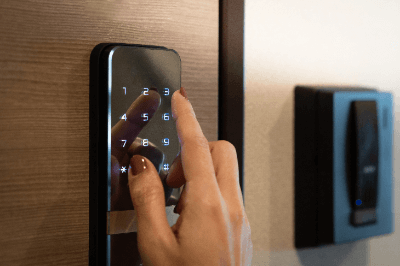What Is a Touch Sensor?

A touch sensor is a sensor that can detect human touch or approach.
Touch sensors are placed on a transparent film substrate and can be operated by switching or selecting a circuit, such as on/off, when touched by a person.
Since touch sensors do not require strong force to operate and are activated by a light touch, they are used in light fixture switches, automatic doors, elevators, etc.
Touch sensors are used in the same principle as touch panels, which are used in cell phones, PC devices, in-vehicle panels, etc.
Applications of Touch Sensors
Since touch sensors are activated by light force, they are often used as switches for automatic doors and lighting fixtures.
Recently, touch sensors are also used in screens of microwave ovens, refrigerators, and coffee servers in convenience stores.
In industrial applications, touch sensors are used as emergency stop buttons on various machines, security sensors, and seating sensors to confirm whether the user is seated.
Touch panels include cell phones, tablet PC devices, in-vehicle panels, game consoles, and business terminals.
Principle of Touch Sensor
Most touch sensors utilize transparent electrodes made of transparent conductive polymers on a glass substrate.
There is also a type of touch sensor called a transparent sheet touch sensor. There are also two main types of touch sensors: capacitive and resistive.
1. Capacitive Type
Since humans are conductors, bringing a hand close to a sensor causes a change in the electrostatic capacitance of the metal plate of the sensor.
The sensor is activated by the change in capacitance of the electrostatic charge, but it may not respond when gloves are worn.
Capacitive sensors are more responsive than resistive sensors, and capacitive sensors are the most common type of sensor used in smartphones these days.
Generally, the capacitive method can be operated with less force than the resistive method and can support two or more touches (multi-touch) at the same time, so the capacitive method is the mainstream in recent smartphones. The figure below shows the main structure of the capacitive method.
Capacitive type configuration of touch sensor
First, the self-capacitance type calculates touch coordinates using the principle that capacitance increases when a finger approaches the sensor electrode.
Next, the mutual capacitance type calculates touch coordinates using the mechanism that if an electric field is formed in advance between the electrode on the transmitter side (transmitter side) and the electrode on the receiver side (receiver side), when a finger approaches the electrode, part of the electric field is directed toward the finger and the capacitance detected at the receiver electrode is reduced.
2. Resistive Film Method
When pressure is applied from above the membrane, the upper and lower membranes make contact and energize to act as a sensor. There are two main types: digital and analog.
One advantage is that detection circuits are easy to design. In addition, it can be operated with gloves on and can be operated not only directly by hand but also with a pen, but on the other hand, it requires more firm pressure than the capacitance method.
One of the main applications is car navigation systems.
Film-Type Touch Sensor
Here we introduce the film-type touch sensor.
While most touch sensors generally employ transparent electrodes on a glass substrate, there are also touch sensors that use transparent film substrates.
As a feature, film-type touch sensors are thinner and lighter than the commonly used glass sensors. Also, there is no risk of them breaking even if dropped. It also offers transparency, which is a feature of glass sensors and is comparable in price.
Since the film base material is extremely soft, it is possible to create not only a flat surface but also a touch sensor with a curved surface design, which is not possible with a glass sensor. There are various sizes of film sensors on the market, ranging from so-called smartphone-sized sensors to large sensors for in-vehicle center information displays.